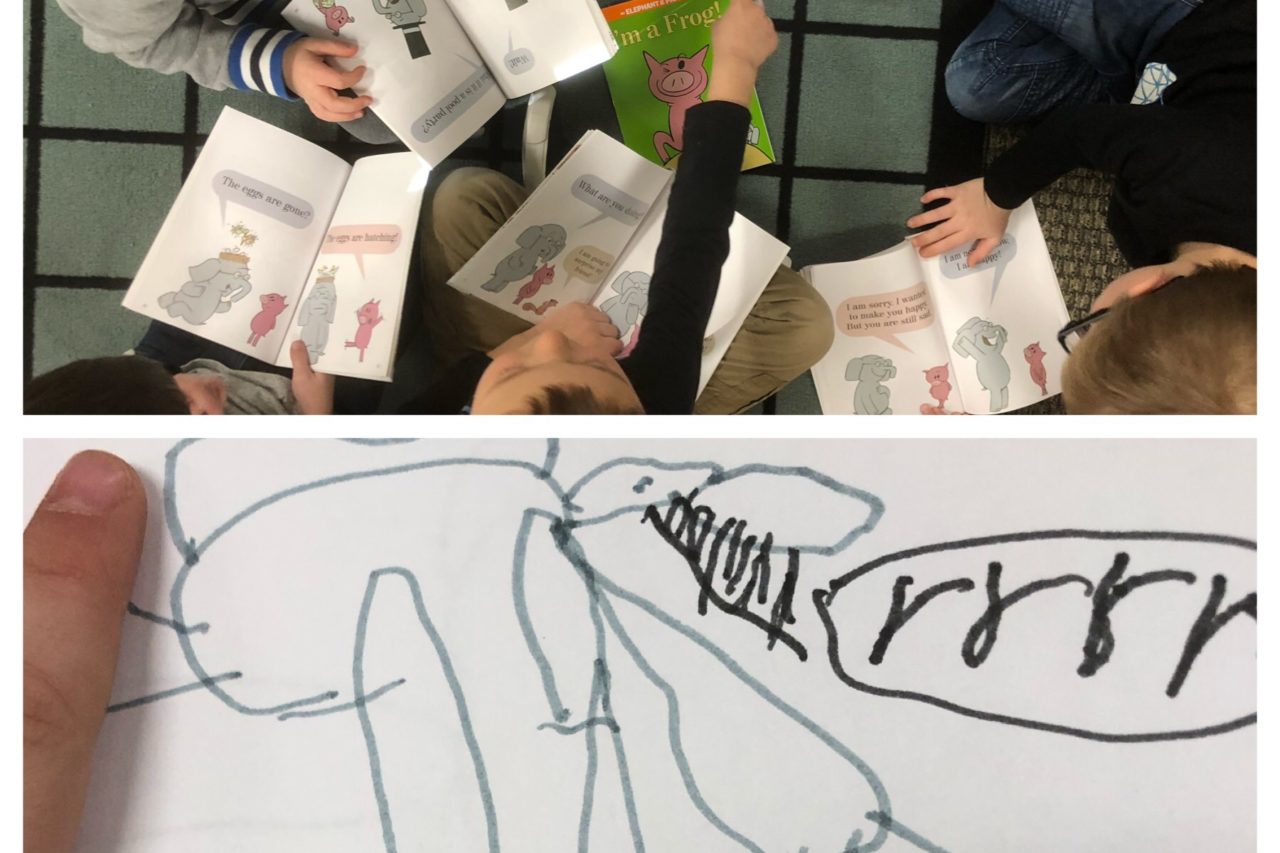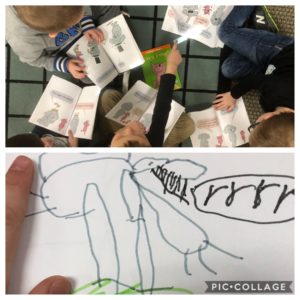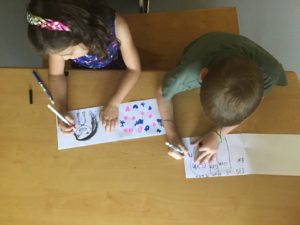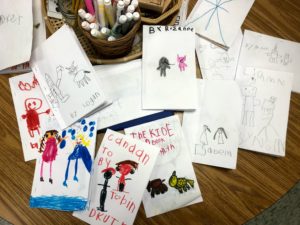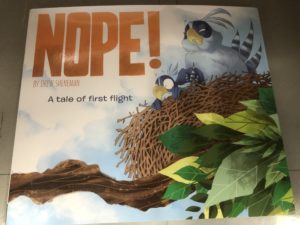
For anyone who has been afraid to try something, Drew Sheneman’s wordless (almost) picture book titled, Nope! is inspiring as a baby bird’s fear of flying is overcome when his mama gives him a swift kick out of the nest, surprisingly bringing him much joy. In this book, young readers can ‘read’ the story through the illustrations using picture clues. Not only that, there is much to learn for students of any age as the author’s craft illustrates showing rather than telling, depicts strong emotions using details of expression and gesture, uses exaggerating features to impact tone, print size and colour to convey meaning, and so much more! This mentor text has become a hit among K teachers and students alike.
Almost all, if not all of us, have mentors in our lives who we observe, listen to, seek advice, model and learn from. We all need mentors who help us learn to be better teachers, parents, friends, competitors, artists, athletes, and so on. The young authors and illustrators in our classroom need mentors as well. Connecting our students with published authors such as James Dean (Pete the Cat), Jan Brett (The Mitten), Mem Fox (Whoever You Are), or Danielle Daniel (Sometimes I Feel Like A Fox) through interviews, write-ups, and blogs can be very inspiring. It brings authenticity to the work of authors and to the authors themselves (see below for links to these and more authors). Take the time to have your students ‘meet’ these authors!
I love how author Corinna Luyken, in The Book of Mistakes, uses playful text and black/white sketches with pops of colour to send a powerful message that we are a work in progress and mistakes are important. Mentor texts become our coaches as teachers and help students envision the kind of writers they can become. As teachers, we can help them to concentrate on writing skills and strategies, ignite their imagination, and empower them to try something new as a budding writer. Mentor texts are texts full of potential to learn from and show students how to write and illustrate for a particular audience with a particular purpose (found in the Communication progression). The use of mentor texts is also connected to the big idea of sharing our stories and listening to others’ stories to help us make meaning of the world around us. Some essential questions are: What stories live in us to share and why do we share them? How can we share the stories in an impactful way? Why do we listen to stories of others? How can we grow a classroom full of writers? How can we nurture the identities of writers in the classroom?
So how do we support growth on this journey of written communication while engaging the writer in authentic writing experiences with opportunities for voice and choice? Katie Wood Ray is the author of five powerful books on what an effective Writers Workshop can look like, with her latest book being, A Teacher’s Guide to Getting Started with Beginning Writers: K-2. It supports her ideas in her ‘must read’ book titled About the Authors, and gives great detail on the very early days of supporting young writers. Kindergarten teachers will particularly benefit by taking a look at Already Ready (Katie Wood Ray) and Engaging Young Writers (Matt Glover) which focus on writers from preschool -Gr. 1.
Over the last couple of years, there have been many HSD teachers across the division who have been inspired by Ray’s books and are using mentor texts with renewed purpose. By far, the majority of the feedback is that students are enthusiastically asking to work on their books and even the reluctant writers are writing under the influence of other authors. The growth has been significant! I had the privilege of being part of the process in some K-4 classes in Elmdale, Kleefeld as well as LES in the last couple of years. I’ve noticed that teachers at Landmark and Kleefeld are already in full swing this year choosing texts full of potential, immersing students in those texts, doing a close study of ‘noticings’ around author decisions, having students articulate the learning, and then and then empowering students to ‘write under the influence’ (Wood Ray’s process). This process cycle, 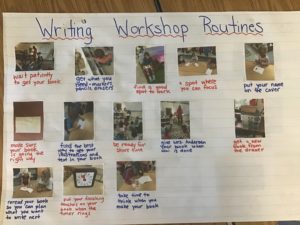 built in with daily mini lessons, is powerful! Currently, if you were to drop in on a LES Gr. 1 classroom , you would see a visual of Writing Workshop routines on the wall complete with personalized pictures of students in action, students using little coloured sticky notes to flag a page where they tried something new in their books, a student reading their finished book to the teacher while checking out the “How do I know I’m finished” chart, or students immersed in and inspired by Mo Willems’ books, noticing the author’s decisions and trying them out in their own books of choice. In a Kleefeld Gr. 1 class, you might hear, as I did, the teacher beginning the workshop by celebrating what she noticed individual students choosing to try in their books the day before. Here’s a snapshot of what it sounded like:
built in with daily mini lessons, is powerful! Currently, if you were to drop in on a LES Gr. 1 classroom , you would see a visual of Writing Workshop routines on the wall complete with personalized pictures of students in action, students using little coloured sticky notes to flag a page where they tried something new in their books, a student reading their finished book to the teacher while checking out the “How do I know I’m finished” chart, or students immersed in and inspired by Mo Willems’ books, noticing the author’s decisions and trying them out in their own books of choice. In a Kleefeld Gr. 1 class, you might hear, as I did, the teacher beginning the workshop by celebrating what she noticed individual students choosing to try in their books the day before. Here’s a snapshot of what it sounded like:
Bree, I noticed that you drew a horizon line so that your characters don’t look like they are floating in space.
Rylan’s detail on his picture told me that the cat was sleeping.
Ethan , I noticed that you used lots of detail on your front cover that matched your title.
Manuel has a cat at home and knows lots about them so he chose that as his topic.
Aiden chose to stretch out a word to help him with the spelling.
Tianna, I noticed that your picture of a dolphin was big and colourful for all to see.
And on it goes. Young writers being celebrated and also being inspired by their peers to try new things in their own books. They will also soon be ready to share more independently as they are learning through the modelling of their teacher.
Check out some ideas to help support your Writers Workshop.
Some Ways to Connect with Authors (click on links)
Bio of James Dean
Author interview on Pete the Cat and the New Guy (start at 1:22)
Jan Brett – Multiple videos, including ones showing how she draws the Gingerbread Baby and other characters. Her blog has personal stories about her animals and the books she is still publishing.
Eric Carle – Includes slide shows and videos of how he does his art
Mem Fox – Includes a page where she answers children’s questions about writing
Kevin Henkes – Includes videos of Kevin talking about his characters, author decisions, and art
David Weisner
Mo Willems
Danielle Daniel – Includes an interview with this Indigenous author
Ideas for Mini lessons (all found in Wood Ray’s books)
The kinds of things writers make and how we’ll make them in this room
Where writers get ideas
How to read like writers
Finding writing mentors
How to structure texts in interesting ways (colour, font, size, placement, etc.)
How to make illustrations work better
How to use punctuation in interesting ways
How to write a particular genre (informative, narrative, persuasive)
How authors title their books, start their books, end their books, etc.
Book flaps, dedications
How writers make text more readable (spelling, formation of letters,) etc.
Ideas for Close Study Questions
What do you notice? What do you notice about…?
What decision did the author/illustrator make? (point to general page or something specific)
Who do you think the author wrote this book for? (particular audiences)
What do think the author’s message is?
Where do we think the author got the idea for this book?
What makes this kind of writing different from other kinds of writing? (narrative vs. information, etc)
What did the author decide to do with the words/text to make them more interesting and effective? (colour, size, placement, font, word choice, etc.)
What do you notice about the punctuation in this book?
What do you notice that makes this….? (non-fiction, a poem, letter, etc.)
After our ‘noticings’ about what this author did, what could you try today in your book/writing/illustrations?
Illustration Close Study
How are the words and the illustrations laid out on the page?
How do the illustrations and the words work together to make meaning?
What was used to create the illustrations? (different media)
How has the illustrator used colour/absence of colour to give meaning?
How did the illustrator show…movement, size, distance, change in time, expression, location, etc.?
Mentor Text Kits can be borrowed from the PLC office by contacting myself, Rhonda Kubanek (rkubanek@hsd.ca), Monica Martens (mmartens@hsd.ca) or Lisa Coulter (licoulter@hsd.ca). Note that within this list of kits, there are even specific Writers Workshop ones to suit the process.
